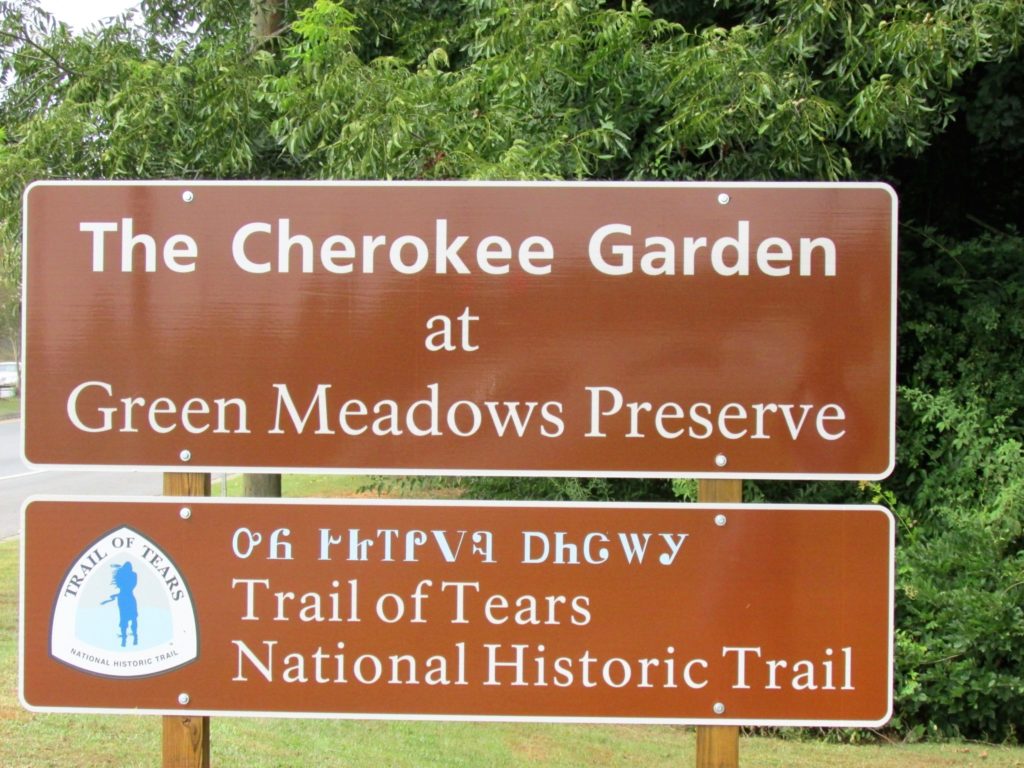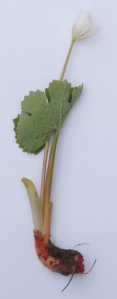Citation: Harris, Tony. “The Cherokee Garden.” Atlanta Studies. April 10, 2023. https://doi.org/10.18737/atls20230410

The Cherokee Garden
Green Meadows Preserve-Cobb County Park System
3780 Dallas Hwy. Marietta, GA
In the early 1800’s all of Cobb County was within the official boundaries of the Cherokee Nation. In 1832 Georgia established the “Land Lottery” and all of the Cherokee lands were distributed to white settlers. Then in May of 1838 the US Army, under the command of General Winfield Scott and with the aid of the Georgia Militia, forcibly removed all Cherokee citizens. The Cherokee were marched to armed camps and forts throughout north Georgia.
In a matter of three weeks, approximately 8000 Georgia Cherokee citizens were rounded up and detained under armed guard. This forced removal is referred to as “The Trail of Tears”. Many people have asked where did the Trail of Tears begin? The Cherokee response is “At the doorstep of every Cherokee home”. Their homeland was taken from them along with the plants that gave them food, medicine, shelter, tools, and weapons.
The Cherokee Garden is a living tribute to the Cherokee way of life here in Georgia. You cannot learn about their culture and history until you understand the unique relationship the Cherokee people had with the land and nature. They had a reverence for the land and for “the Creator” that supplied all their needs. They believed that it was the Cherokee’s responsibility to discover what the Creator provided through nature and then to protect it. The Cherokee way of life offers many lessons that we can apply to our lives today.
The Cherokee Garden is a significant educational resource available to the public free of charge. The garden is open to the public every day and with special tours offered to school children and civic organizations. Each Cherokee plant in the garden has a plant sign with a QR Code. Just scan the plant sign with your smartphone and it will take you to a website that will explain the plant characteristics and how the Cherokee used each plant. In 2014 Cobb County Parks Department officially opened Green Meadows Preserve as the site for The Cherokee Garden in cooperation with Cobb County Master Gardeners Project and the National Park Service. Initially, funding was an issue but the Master Gardeners kept working away at invasive plant removal, creating planting beds, and constructing an enclosed heirloom Cherokee vegetable garden. With the cooperation of the Georgia Native Plant Society, the volunteers went on plant rescues to acquire the native medicinal plants. As friends became aware of the Cherokee Garden, many donated special plants from their own garden.


Here are some of the plants that were important in Cherokee culture. Blood Root is a tuber that produces a beautiful white flower in early March and its roots secrete a red liquid that was used as a red dye and also to treat skin ailments. Wild Ginger was used as a tonic for the elderly, as a digestive aid, and was added to 70% of all Cherokee medicinal formularies. The heirloom vegetable garden uses authentic seeds received from the Cherokee Nation seed bank. The Cherokee Garden is surrounded by Black Walnut trees which the Cherokee used for food, crafts, black dye, and many medicinal uses. Tulip Poplar trees were also very important, they were used for canoes and home-building, and the inner bark was used for medicine.
Without the Master Gardeners supporting the project with over 5,000 volunteer hours, the Cherokee Garden would still be in its infancy. The garden has had many of the same volunteers since the beginning. It is quite rewarding working with friends who share your vision and passion. Although there is joy in realizing how much has been accomplished in eight years, there are still long-range goals that are in the planning stage. We would love to incorporate more native trees and medicinal shrubs and increase our inventory of small medicinal plants.
Tony Harris is the Cherokee Garden’s project chairman. He is a Cherokee Nation citizen and elder. He is passionate about preserving his Cherokee heritage and culture here in the original Cherokee homeland. Although Tony was raised and educated in the Cherokee Nation in Oklahoma, his ancestral lineage goes back to the Forsyth County area.